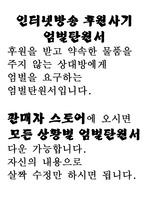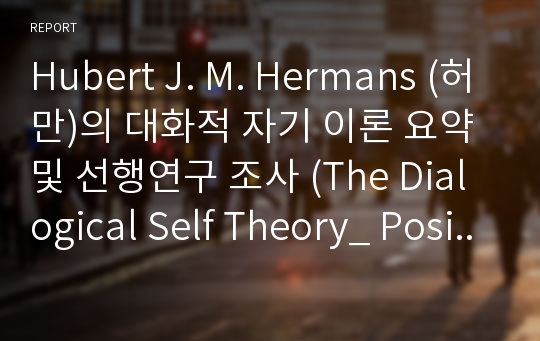Hubert J. M. Hermans (허만)의 대화적 자기 이론 요약 및 선행연구 조사 (The Dialogical Self Theory_ Positioning and Counter-Positioning in a Globalizing Society)
비츠프로
다운로드
장바구니
목차
I. 서론1. 들어가기 / 저자 소개
II. 선행연구
1. 대화적 자기이론의 기원이 된 Hermans의 앞선 연구들
2. 최근 연구동향
3. 정리
III. “Dialogical Self Theory”의 이해
1. 공간적, 시대적 관점에서 본 대화적 자기의 발달
2. 자기 정체성
3. 자기의 통합(Unity)과 연속성(continuity)
4. The positioning and dialogue in life-long development
5. 감정의 대화적인 시각 (박3 방수진)
6. 조직, 동기, 그리고 갈등 해소를 위한 실용적인 시사점
V. 마치며
Ⅵ. 참고문헌
본문내용
다양성. 이 한 단어 안에 담긴 의미는 3글자로 담기에는 너무 부족한 것 같다. 수천 년의 역사를 이어오면서 반복적 시대 조류나 패러다임이 있어왔지만, 어쩌면 포스트모더니즘의 현대 시대처럼 다양성이란 이름이 각 분야와 사람들에게 이처럼 강력한 영향을 주는 때는 일찍이 없었던 것 같다. 자연과학을 비롯한 첨단 과학의 발달, 세계화라는 이름에 걸맞는 정보통신교통의 발달, ‘정말로’ 하늘 아래 새로운 것이 없을 만큼 엄청난 자료들의 홍수 등은 다양성이란 현상에 상상할 수 없는 시너지 효과를 제공한 듯하다.많은 분야의 학자들, 그리고 현장에서는 다양성이란 역사적 현상을 단순히 ‘많다,’ ‘여럿하다,’ ‘다르다’라는 개념에서 확장하여, 존재의 다양성을 증거하는 구조적 측면에서 접근하고 있다. 서로 다름을 인정한다는 고전적인 다양성에 대한 접근에서 발전하여 상호 영향을 주고받는 관계성, 그리고 모든 유기체적 존재들의 연결성에서 다양성의 개념은 두루 쓰이고 있다.
Hermans는 단일하게 보이는 현상, 즉 한 개인의 인생 내러티브 역시 다양성을 내포하고 있는 다중적 자기의 결과물이라고 이야기한다. 분열, 파편이라는 이름으로 통일성을 정신의 지향점으로 삼고 있던, (심지어 얼마전까지 그러나 지금도 여전히 주장하고 있는) 모더니즘적 관점에서 보면 다중적 자기는 치료의 대상이 된다. 하지만 종이 한 장의 아슬한 경계를 넘어 긍정성을 우리 마음에 품고 다시금 바라보게 된다면, 균형과 조화의 시각에서 다양성은 절묘한 체계로 보일 수 있게 된다.
1950년대, 그레고리 베이트슨이 주장한 사이버네틱스 그리고 체계적 사고는 전체 구조에 대한 상위와 하부 구조간의 영향력 그리고 독립적 존재로서의 생명력을 새롭게 불어넣어주었다. 여기에서 다양성이란 평등과 균등을 넘어서는 독립적 존재들의 합을 이야기하기도 하며, 그 총체는 단순한 합 이상이라는 체계의 특징을 보여주기도 한다.
참고 자료
Hermans, H., & Hermans-Konopka, Agnieszka (2010). Dialogical Self Theory: Positioning and Counter-Positioning in a Globalizing Society. Cambridge University Press;Hermans, H. J. (1970). A questionnaire measure of achievement motivation. Journal of Applied Psychology, 54(4), 353-363.
Hermans, H. J., Laak, J. J., & Maes, P. C. (1972). Achievement motivation and fear of failure in family and school. Developmental Psychology, 6(3), 520-528.
Hermans, H. J. (1987). The dream in the process of valuation: A method of interpretation. Journal of Personality and Social Psychology, 53(1), 163-175.
Hermans, H. J., Hermans-Jansen, E., & Gilst, W. (1987). The fugit amor experience in the process of valuation: A self-confrontation with an unreachable other. British Journal of Psychology, 78(4), 465-481.
Hermans, H. J. (1988). On the Integration of Nomothetic and Idiographic Research Methods in the Study of Personal Meaning. Journal of Personality, 56(4), 785-812.
Hermans, H. J., & Bonarius, H. (1991). Static laws in a dynamic psychology? European Journal of Personality, 5(3), 245-247.
Hermans, H. J., & Gilst, W. V. (1991). Self-narrative and collective myth: An analysis of the Narcissus story. Canadian Journal of Behavioural Science/Revue canadienne des sciences du comportement, 23(4), 423-440.
Hermans, H. J., Kempen, H. J., & Loon, R. J. (1992). The dialogical self: Beyond individualism and rationalism. American Psychologist, 47(1), 23-33.
Dimaggio, G., Catania, D., Salvatore, G., Carcione, A., & Nicolò, G. (2006). Psychotherapy of paranoid personality disorder from the perspective of dialogical self theory. Counselling Psychology Quarterly, 19(1), 69-87.
Dimaggio, G., Fiore, D., Lysaker, P. H., Petrilli, D., Salvatore, G., Semerari, A., & Nicolò, G. (2006). Early narcissistic transference patterns: An exploratory single case study from the perspective of dialogical self theory. Psychology and Psychotherapy: Theory, Research and Practice, 79(4), 495-516.
Elshaikh, E. (2011). Dialogical Self in Tennyson’s “Ulysses” and Farooq Guwaida’s “A Star Looking for an Orbit”. The International Journal of Interdisciplinary Social Sciences: Annual Review, 5(9), 393-404.
Grimmett, H. (2016). The Problem of “Just Tell Us”: Insights from Playing with Poetic Inquiry and Dialogical Self Theory. Studying Teacher Education, 12(1), 37-54.
Gube, J. (2017). Sociocultural trail within the dialogical self: I-positions, institutions, and cultural armory. Culture &Psychology, 23(1), 3-18.
Hong, J., Greene, B., &Lowery, J. (2016). Multiple dimensions of teacher identity development from pre-service to early years of teaching: a longitudinal study. Journal of Education for Teaching, 43(1), 84-98.
Ligorio, M. B., & Pugliese, A. C. (2004). Self-Positioning in a Text-Based Virtual Environment. Identity, 4(4), 337-353.
Long, Z., Buzzanell, P. M., & Kuang, K. (2016). Positioning Work Amid Discontinuities and Continuities: Chinese Post80s Workers Dialogical Constructions of Meanings of Work. Management Communication Quarterly, 30(4), 532-556.
Lysaker, P. H., & Hermans, H. J. (2007). The dialogical self in psychotherapy for persons with schizophrenia: A case study. Journal of Clinical Psychology, 63(2), 129-139.
Meijl, T. V. (2012). Multicultural adolescents between tradition and postmodernity: Dialogical Self Theory and the paradox of localization and globalization. New Directions for Child and Adolescent Development, 2012(137), 39-52.
Prokopiou, E., Cline, T., & Abreu, G. D. (2012). "Silent" monologues, "loud" dialogues and the emergence of hibernated I-positions in the negotiation of multivoiced cultural identities. Culture &Psychology, 18(4), 494-509.
Rojas-Mcwhinney, J., & Bell, N. J. (2016). The negotiation of parenting beliefs by Mexican American mothers and fathers of young children. Journal of Family Studies, 23(1), 19-37.
Raggatt, P. T., & Weatherly, T. (2014). Has Average Joe Got Inner Conflicts? Positioning the Self and the Meaning of Mid-Range Scores on the Big Five Traits. Journal of Constructivist Psychology, 28(2), 152-165.
Raggatt, P. T. (2015). Positioning: Dialogical voice in mind and culture. Theory &Psychology, 25(6), 775-797.
Smythe, W. (2013). The Dialogical Jung: Otherness within the Self. Behavioral Sciences, 3(4), 634-646.
Stone, S. A., Dekoeyer-Laros, I., & Fogel, A. (2012). Self and other dialogue in infancy: Normal versus compromised developmental pathways. New Directions for Child and Adolescent Development, 2012(137), 23-38.
Toompalu, A., Leijen, Ä, & Kullasepp, K. (2016). Professional role expectations and related feelings when solving pedagogical dilemmas: a comparison of pre- and in-service teachers. Teacher Development, 21(2), 307-323.
Watzlawik, M., & Kullasepp, K. (2016). Career as Affective Journey: How Constant Flux Challenges the Search for Career Pathways and Counseling. Integrative Psychological and Behavioral Science, 50(3), 492-506.
강재린 (2016) 프래그머티즘에 기반 한 ‘대화적 자아(dialogical self)’개념의 철학교육 적용가능성. 석사학위논문, 이화여자대학교 대학원.
김삼진 외 (2012). 덕양중학교 혁신학교 도전기. 서울: 맘에드림.
박영숙 (2014). 회복적 생활교육을 만나다. 서울: 좋은교사.
손은희 (2010). 자기직면법 프로그램이 아동의 우울감 및 자아존중감에 미치는 효과. 석사학위논문, 경북대학교 대학원.
손은희, 김춘경 (2011). 자기직면법 집단상담 프로그램이 아동의 우울감 감소에 미치는 효과. 놀이치료연구, 15(3), 81-99.
송재홍 (2003). 교대생의 내면적 가치평가에 대한 유형별 내용분석: 원형적 접근. 상담학연구, 4(1), 37-51.
유은지 (2016). 학생의 학업성취도 및 학교만족도에 대한 혁신학교 성과 분석. 석사학위논문, 고려대학교 대학원.
한영욱 (2015). 혁신학교의 교사문화 형성에 관한 질적 사례 연구. 석사학위논문, 한국교원대학교 대학원.



























